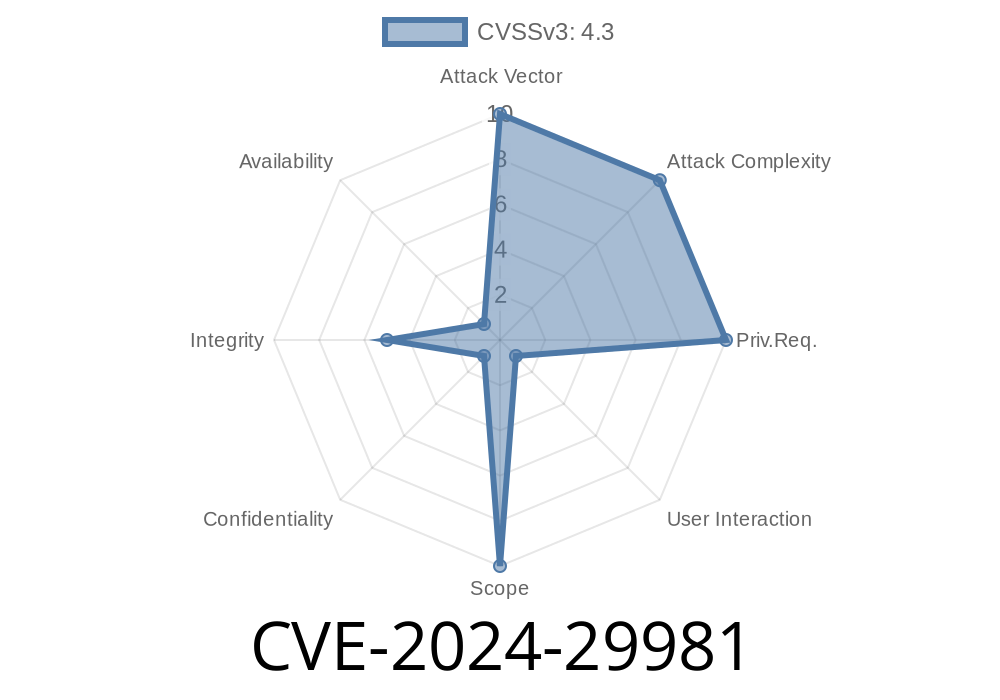When we browse the vast playground that is the internet, we put our faith in the many security measures meant to protect us. Lately, this trust has been challenged by a new vulnerability that has come to light in Microsoft Edge, a renowned Chromium-based browser. This vulnerability allows malicious actors to carry out a deception as they can "spoof" a web address to appear as legitimate. As you read this post, we'll dive deep into this spoofing vulnerability CVE-2024-29981, showing code snippets, links to original references, and in-depth analysis of its exploitability.
Vulnerability Details
CVE-2024-29981 is a recently discovered vulnerability that resides in the Chromium-based Microsoft Edge web browser. It allows attackers to display a false URL while showcasing a malicious website's content, essentially tricking users into believing that they are visiting a legitimate site. Consequently, this opens up myriad possibilities for identity theft, data breaches, and phishing scams to compromise user data.
How does this exploit work?
Malicious actors utilize a specially crafted website to deceive users and manipulate the browser's address bar. When this page is visited by an unsuspecting user, attackers can display a seemingly safe URL, even though the actual content is malicious. This deceptive tactic is successful since users often rely on the address bar as an indicator of security and trustworthiness of a website.
Code Snippet
Below is a sample code snippet that demonstrates how cybercriminals can execute the address bar spoofing vulnerability.
<!DOCTYPE html>
<html>
<head>
<title>RealSite</title>
</head>
<body>
<h1>RealSite</h1>
<p>This is a fake site pretending to be RealSite.</p>
</body>
<script>
history.pushState("", "", "/RealURL");
</script>
</html>
In this example, a user would visit the malicious website displaying the contents of RealSite. When the browser renders the page, the JavaScript function history.pushState() manipulates the address bar, updating it to show /RealURL. However, the user is still viewing the malicious content, completely unaware of the deception.
Original References
The vulnerability was brought to light by security researchers who presented it to Microsoft as part of the responsible disclosure process. Links to the original references are provided below for further insight:
1. Microsoft's Official Security Advisory
2. National Vulnerability Database (NVD) Entry
3. Common Vulnerabilities and Exposures (CVE) Record
Mitigations and Workarounds
Microsoft has addressed this vulnerability by releasing a patch in subsequent updates for the Microsoft Edge browser. Users are advised to keep their browser up to date to avoid any potential risks. Stay vigilant and always check the legitimacy of the websites you visit, especially when providing personal information or downloading files.
Conclusion
Cybersecurity must evolve continuously to counter the limitless tactics and loopholes malicious actors aim to exploit. This post aimed to expand knowledge on the CVE-2024-29981 vulnerability in Microsoft Edge. By staying informed, adopting proactive security practices, and ensuring that our software is always up to date, we can better safeguard ourselves from the ever-growing threats of the digital realm. Stay safe, and browse responsibly.
Timeline
Published on: 04/04/2024 22:15:09 UTC
Last modified on: 04/09/2024 17:16:00 UTC
